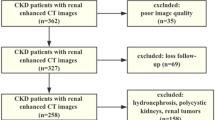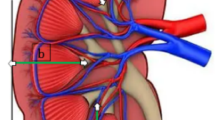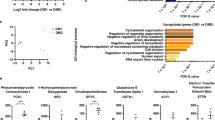Abstract
Background
To evaluate sensitivity, specificity, and positive and negative predictive values (PPV and NPV, respectively) of renal ultrasonography (US) in predicting renal uptake defects or reduced renal function at Tc-99m dimercaptosuccinic acid (DMSA) scan (primary outcome). We also evaluated which factors could be associated with Tc-99m DMSA renal scan anomalies.
Methods
We retrospectively included all the patients with vesico-ureteral reflux (VUR) undergoing the first Tc-99m DMSA renal scan within 3 months from the most recent renal US between 2016 and 2018.
Results
Sensitivity, specificity, PPV, and NPV of US in predicting abnormal Tc-99m DMSA scan were 38.9%, 91.5%, 71.9%, and 72.9%, respectively. Different length between the kidneys, expressed as standard deviation score (SDS), showed an area under the receiver operating characteristic curve of 0.70 (95% CI, 0.60–0.80; p < 0.0001) when evaluated as predictor of abnormal Tc-99m DMSA scan. A different length between the two kidneys >1.11 SDS had 91.5% sensitivity and 57.6% specificity. At multivariate analysis, the factors with significantly increased odds ratio of abnormal Tc-99m DMSA scan were difference in length between two kidneys >1.11 SDS and dilated VUR.
Conclusions
The Tc-99m DMSA scan remains the gold standard to detect renal parenchymal anomalies. A different length between the kidneys >1.11 SDS and dilated VUR are predictors of abnormal Tc-99m DMSA renal scan.
Similar content being viewed by others
Log in or create a free account to read this content
Gain free access to this article, as well as selected content from this journal and more on nature.com
or
References
Bailey, R. R. The relationship of vesico-ureteric reflux to urinary tract infection and chronic pyelonephritis-reflux nephropathy. Clin. Nephrol. 1, 132–141 (1973).
Shaikh, N. et al. Early antibiotic treatment for pediatric febrile urinary tract infection and renal scarring. JAMA Pediatr. 170, 848 (2016).
Karavanaki, K. et al. Fever duration during treated urinary tract infections and development of permanent renal lesions. Arch. Dis. Child. 104, 466–470 (2019).
Ardissino, G. et al. Epidemiology of chronic renal failure in children: data from the ItalKid project. Pediatrics 111, e382–e387 (2003).
Marzuillo, P. et al. Outcomes of a cohort of prenatally diagnosed and early enrolled patients with congenital solitary functioning kidney. J. Urol. 198, 1153–1158 (2017).
Marceau-Grimard, M. et al. Dimercaptosuccinic acid scintigraphy vs. ultrasound for renal parenchymal defects in children. Can. Urol. Assoc. J. 11, 260–264 (2017).
Kass, E. J., Kernen, K. M. & Carey, J. M. Paediatric urinary tract infection and the necessity of complete urological imaging. BJU Int. 86, 94–96 (2000).
Preda, I., Jodal, U., Sixt, R., Stokland, E. & Hansson, S. Normal dimercaptosuccinic acid scintigraphy makes voiding cystourethrography unnecessary after urinary tract infection. J. Pediatr. 151, 581–584 (2007).
Subcommittee on Urinary Tract Infection, Steering Committee on Quality Improvement and Management& Roberts, K. B. Urinary tract infection: clinical practice guideline for the diagnosis and management of the initial UTI in febrile infants and children 2 to 24 months. Pediatrics 128, 595–610 (2011).
National Institute for Health and Clinical Excellence. Urinary tract infection in children: diagnosis, treatment and long-term management https://www.ncbi.nlm.nih.gov/pubmed/21290637 (2007).
Ammenti, A., et al. Updated Italian recommendations for the diagnosis, treatment and follow up of the first febrile urinary tract infection in young children. Acta Paediatr. https://doi.org/10.1111/apa.14988 (2019).
Fahey, F. H. et al. Dose estimation in pediatric nuclear medicine. Semin. Nucl. Med. 47, 118–125 (2017).
Expert Panel on Pediatric Imaging et al. ACR Appropriateness Criteria® Urinary Tract Infection-Child. J. Am. Coll. Radiol. 14, S362–S371 (2017).
Ammenti, A. et al. Febrile urinary tract infections in young children: recommendations for the diagnosis, treatment and follow-up. Acta Paediatr. 101, 451–457 (2012).
Gordon, Z. N. et al. Uroepithelial thickening improves detection of vesicoureteral reflux in infants with prenatal hydronephrosis. J. Pediatr. Urol. 12, 257.e1-7 (2016).
Marzuillo, P. et al. Antibiotics for urethral catheterization in children undergoing cystography: retrospective evaluation of a single-center cohort of pediatric non-toilet-trained patients. Eur. J. Pediatr. 178, 423–425 (2019).
Marzuillo, P. et al. Cleaning the genitalia with plain water improves accuracy of urine dipstick in childhood. Eur. J. Pediatr. 177, 1573–1579 (2018).
Marzuillo, P. et al. Congenital solitary kidney size at birth could predict reduced eGFR levels later in life. J. Perinatol. 39, 129–134 (2018).
Patel, K., Charron, M., Hoberman, A., Brown, M. L. & Rogers, K. D. Intra- and interobserver variability in interpretation of DMSA scans using a set of standardized criteria. Pediatr. Radiol. 23, 506–509 (1993).
Moorthy, I., Wheat, D. & Gordon, I. Ultrasonography in the evaluation of renal scarring using DMSA scan as the gold standard. Pediatr. Nephrol. 19, 153–156 (2004).
Temiz, Y., Tarcan, T., Onol, F. F., Alpay, H. & Simşek, F. The efficacy of Tc99m dimercaptosuccinic acid (Tc-DMSA) scintigraphy and ultrasonography in detecting renal scars in children with primary vesicoureteral reflux (VUR). Int. Urol. Nephrol. 38, 149–152 (2006).
Veenboer, P. W. et al. Diagnostic accuracy of Tc-99m DMSA scintigraphy and renal ultrasonography for detecting renal scarring and relative function in patients with spinal dysraphism. Neurourol. Urodyn. 34, 513–518 (2015).
Roebuck, D. J., Howard, R. G. & Metreweli, C. How sensitive is ultrasound in the detection of renal scars? Br. J. Radiol. 72, 345–348 (1999).
Kersnik Levart, T. et al. Sensitivity of ultrasonography in detecting renal parenchymal defects in children. Pediatr. Nephrol. 17, 1059–1062 (2002).
Shanon, A. et al. Evaluation of renal scars by technetium-labeled dimercaptosuccinic acid scan, intravenous urography, and ultrasonography: a comparative study. J. Pediatr. 120, 399–403 (1992).
Sinha, M. D., Gibson, P., Kane, T. & Lewis, M. A. Accuracy of ultrasonic detection of renal scarring in different centres using DMSA as the gold standard. Nephrol. Dial. Transpl. 22, 2213–2216 (2007).
Rickwood, A. M. et al. Current imaging of childhood urinary infections: prospective survey. BMJ 304, 663–665 (1992).
La Scola, C. et al. Different guidelines for imaging after first UTI in febrile infants: yield, cost, and radiation. Pediatrics 131, e665–e671 (2013).
Kleinerman, R. A. Cancer risks following diagnostic and therapeutic radiation exposure in children. Pediatr. Radiol. 36, 121 (2006).
Peters, C. & Rushton, H. G. Vesicoureteral reflux associated renal damage: congenital reflux nephropathy and acquired renal scarring. J. Urol. 184, 265–273 (2010).
Stokland, E., Hellström, M., Jakobsson, B. & Sixt, R. Imaging of renal scarring. Acta Paediatr. Suppl. 88, 13–21 (1999).
Acknowledgements
The authors thank Simona Malvone for the revision of the written English.
Author contributions
Each author has met the Pediatric Research authorship requirements. Research idea and study design: P.M., S.G.; data acquisition: D.C., N.M., G.C., P.F.R.; data analysis/interpretation: P.M., A.L.M., E.M.D.G., S.G.; statistical analysis: P.M., E.M.D.G., S.G.; supervision or mentorship: N.M., G.C., P.F.R., A.L.M. Each author contributed important intellectual content during manuscript drafting or revision.
Author information
Authors and Affiliations
Corresponding author
Ethics declarations
Competing interests
The authors declare no competing interests.
Additional information
Publisher’s note Springer Nature remains neutral with regard to jurisdictional claims in published maps and institutional affiliations.
Rights and permissions
About this article
Cite this article
Guarino, S., Capalbo, D., Martin, N. et al. In children with urinary tract infection reduced kidney length and vesicoureteric reflux predict abnormal DMSA scan. Pediatr Res 87, 779–784 (2020). https://doi.org/10.1038/s41390-019-0676-1
Received:
Revised:
Accepted:
Published:
Issue date:
DOI: https://doi.org/10.1038/s41390-019-0676-1
This article is cited by
-
Kidney involvement during the course of febrile urinary tract infection
Pediatric Nephrology (2025)
-
Clinical implications of primary “occult” vesicoureteral reflux in male children
European Radiology (2024)
-
Body surface area-based kidney length percentiles misdiagnose small kidneys in children with overweight/obesity
Pediatric Nephrology (2023)
-
Evolution of congenital anomalies of urinary tract in children with and without solitary kidney
Pediatric Research (2022)
-
Demographic, clinical, and laboratory factors associated with renal parenchymal injury in Iranian children with acute pyelonephritis
BMC Infectious Diseases (2021)



